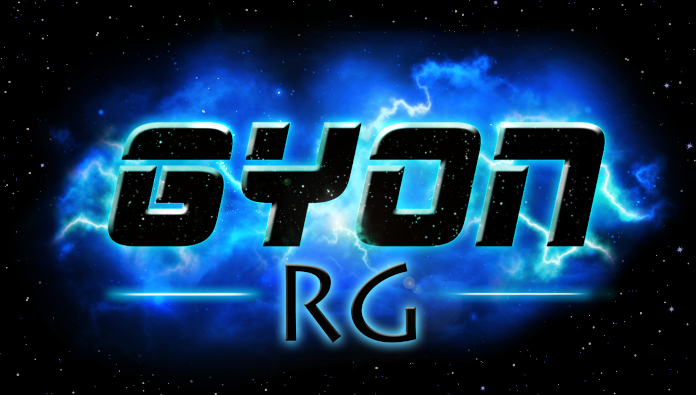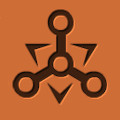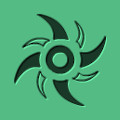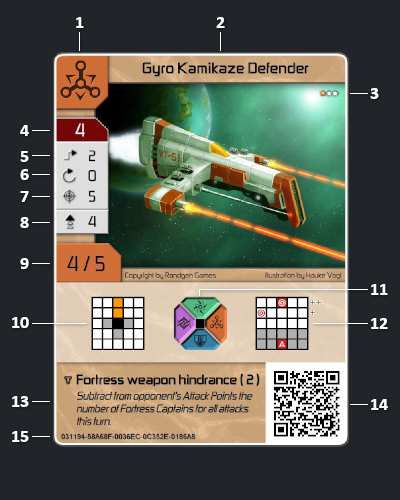

What is Gyon-RG
Gyon-RG is a strategy trading card game composed of randomly generated cards. This means that there are no predefined cards. Instead, there is a set of attributes that are randomly selected during card production allowing a huge number of combinations. Gyon-RG can currently generate more than 13 trillion different cards.
Game objective
A player must collect 10 Victory Points or conquer the opponent’s Main Sector to win the game.
Board
Actually, there is no board. Gyon-RG is played on an imaginary 5x5 grid. Each position on that grid is a sector that can be occupied by a ship or a fleet. A sector can only be occupied by one player at a time.
Elements





There are five elements in Gyon-RG considered the five existence fluctuations: Matter (orange cards), Antimatter (purple cards), Light (green cards), Shadow (blue cards) and Void (grey cards). Each card belongs to one of these elements.
Captains and fleets
A sector can be occupied by one or more ships. If only one ship occupies a sector, that will be considered the Captain. When more than one ship stacks at the same sector, it is called a fleet and its ships will be ordered by its shield value (9) from higher to lower. The ship with higher shield value will be on top and will be called the Captain. If two ships have the same shield value, the one with higher attack value will stay above. When ships have the same shield and attack values, the player chooses its order.
Basically, Captains are the visible cards on board.
Card

Each card represents one Ship and one Special. Here is an explanation of all card details:
1. Element
Also indicated by card color.
2. Ship's name
Ship's name is composed by ship type (in this case, Defender) and one or two modifiers (in this case, ship has two modifiers, Gyro and Kamikaze). Each modifier changes the ship's base attributes.
3. Stars
Since all attributes have its own probability to be selected, cards can be more os less probable. Stars represent the card probability.
 Common
Common
 Rare
Rare
 Epic
Epic
 Legendary
Legendary
4. Deploy cost
Shows how many Action Points the player must spend to place the card on board.
5. Move cost
Shows how many Action Points the player must spend to move.
6. Rotate cost
Shows how many Action Points the player must spend to rotate.
7. Attack cost
Shows how many Action Points the player must spend to attack.
8. Speed
The number of sectors that can be traveled in each movement action.
9. Attack / Shield
Show the ship’s attack and shields values (first number is attack, second is shield).
10. Weapon and Blindspot
Orange squares shows the range of weapon in relation to the current ship's position. Grey squares shows the ship's blindspot.
11. Deploy diagram
This shows which elements can be deployed in free sectors above, below, left or right of the ship.
12. Goal grid
Shows which sectors count for Victory Points when the ship is placed on these sectors at the beginning of each turn. A target with a red background represents the opponent's main sector and is the same for all cards.
13. Special
Show the Special, its cost and effect.
14. QR Code
Read it to access the full set of information and statistics for the card.
15. Serial
Identifies a unique card configuration. Like the QR Code, can also be used to access the full set of information and statistics for the card.
Start of game
Players start with a 54 card deck already shuffled and cut by the opponent. Any method can be used to select the starting player.
Each player draws 5 cards from the deck and may refuse them. If so, the player returns cards to the deck and repeats the process from start. This is called Mulligan and can be done only once.
The rest of the cards will be placed on the player's left side while the right side will receive destroyed ships, also called the scrap yard.
Turn development
Each turn develops with the following sequence:
Count Victory Points (or end of game)
At the start of its round, the player counts Victory Points. For each Captain standing on a goal sector (12) the player receives as Victory Points the value of Captain’s Deploy Cost (4). If the ship is on its 4th row (marked by a +), the player will receive one more point. If the ship is on its 5th row (marked by a ++), the player will receive two more points.
If the player is occupying the opponent’s main sector, the game ends with a victory. Opponent's main sector can only be occupied if opponent has at least one card on board.
Use Secial for player's turn
A Special (13) can be selected for use in player’s turn by subtracting its cost from Action Points.
Special must be a card in player’s hand. Player reads its description and puts card aside for the opponent to know its affect.
Specials usage is not mandatory.
If the use of a Special turns a ship attribute into a negative value, that value will be considered zero.
Board actions
Board actions always stars with 5 cards in player's hand. Draw cards if necessary (for example, if a special was used).
Action Points can be used for deploying, moving, rotating and attacking ships.
Deploy
In each turn, the player can place on board as many ships as wanted, as long as Action Points are not exceeded. This is called deploy.
A single ship or a fleet can be deployed at the same time. Action Points will be subtracted by the total ships deploy cost (4).
First deployment of a player in a game will always be to its main sector and the player can deploy to its main sector at will as long as it is not occupied. To deploy in other sectors, the following rules applies:
Sector must be empty.
Sector must be adjacent to an already occupied sector.
A Captain can only be deployed if it belongs to the element shown in the adjacent Captain’s deploy diagram (11). For instance, for the shown card example, at its left can only deploy a Matter Captain, above a Shadow Captain, below an Antimatter Captain and to the left a Light Captain. Void Captains don’t follow this rule and can be deployed in any of them.
Move
In each turn, the player can move as many deployed ships as wanted, as long as Action Points are not exceeded. For each move, only the Captain’s move cost (5) will be subtracted from Action Points available.
In a move, the Captain can take the full fleet or part of it (or even move alone). The player can also move ships from the fleet, forming a new fleet with a new Captain. In this case, the move cost applied will be the new Captain's move cost. Ships can move into an already occupied sector, joining a fleet.
The number of sectors a Captain can move is given by its speed value (8).
Movement cannot be done diagonally and can be done through player's occupied sectors but not through opponent's.
Rotate
In each turn, the player can rotate as many ships as wanted, as long as Action Points are not exceeded. For each rotation, only the Captain’s rotate cost (6) will be subtracted from Action Points available.
Rotation is made for attacking and, after the attack, ships return to its original position, always facing towards the opponent.
When a Captain rotates, the fleet also rotates - it is not allowed to have ships pointing in different directions in the same sector.
Attack
In each turn, the player can attack as many times as wanted, as long as Action Points are not exceeded. For each attack, only the corresponding Captain’s attack cost (7) will be subtracted from Action Points available.
To obtain Attack Points, the player sum the attack values (9) for all ships in the fleet, adding 1 if the attack is being done from the target blind stop (10).
Attack Points must be greater than targeted Captain shield value (9) for the attack to occur and the following ships in a fleet can be also destroyed as long the remaining Attack Points are enough (each destroyed ship subtract its shield value from Attack Points). For instance, if the Attack Points are 10 and targeted fleet has ships with shields 6, 3, and 2 by this order, the first two will be destroyed (6 + 3 = 9) but the remainder Attack Point is not enough to destroy last ship (6 + 3 + 2 = 11).
Destroyed ships are placed in the Scrap Yard.
Discard and Draw
At the end of its turn, used Special return to player's hand and player can then discard any unwanted cards and put them in the Scrap Yard.
While there are still cards left to be drawn, player will draw until 5 cards are in hand.
Use Secial for opponent's turn
A Special (13) can also be selected for opponents’s turn if remaining Action Points are still enough to pay Special's cost.
Usage is the same as described in player's turn.
After opponent's turn ends, Special return to player hand.
Drones
Drones are a special type of ship. When places on board, can be replaced by any ship or fleet subtracting from Action Points the deploy cost (4) of all ships replaced.
Deck building
The maximum number of Drones in a deck is three.
Final thoughts
This describes how we thought the game should be played but you may play it as you wish if you find it more compelling. Hope you enjoy it as much as we did developing it.